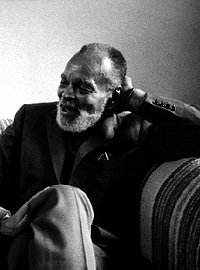Biography
(courtesy of wikipedia.com) Chester Himes was born in Jefferson City, Missouri on July 29, 1909. He grew up in a middle-class home in Missouri and in Ohio (and) attended East High School in Cleveland Ohio. While he was a freshman at Ohio State University in Columbus Ohio, he was expelled for a prank. Years later, he entered prison for armed robbery. In prison, he wrote short stories and had them published in national magazines. Himes stated that writing and publishing was a way to earn respect from guards and fellow inmates, as well as avoid violence.
Chester Himes was born in Jefferson City, Missouri on July 29, 1909. He grew up in a middle-class home in Missouri and in Ohio (and) attended East High School in Cleveland Ohio. While he was a freshman at Ohio State University in Columbus Ohio, he was expelled for a prank. Years later, he entered prison for armed robbery. In prison, he wrote short stories and had them published in national magazines. Himes stated that writing and publishing was a way to earn respect from guards and fellow inmates, as well as avoid violence.
By the 1950s Himes had decided to settle in France permanently, a country he liked in part due to his critical popularity there. In Paris Himes was the contemporary of the political cartoonist, Oliver Harrington, and fellow writers, Richard Wright and James Baldwin.
Some regard Chester Himes as the literary equal of Dashiell Hammett and Raymond Chandler. Ishmael Reed says "[Himes] taught me the difference between a black detective and Sherlock Homes" and it would be more than 30 years until another Black mystery writer, Walter Mosley and his Easy Rawlins and Mouse series, had even a similar effect.
Works
(again, wikipedia.com)
Himes's novels encompassed many genres including the crime novel/mystery and political polemics, exploring racism in the United States. He wrote about African Americans in general, especially in two books that are concerned with labor relations and African American workplace issues. If He Hollers Let Him Go — contains many autobiographical elements—is about a black shipyard worker in Los Angeles during World War II struggling against racism as well as his own violent reactions to racism. Lonely Crusade is a longer work that examines some of the same issues. Cast the First Stone is based on Himes's experiences in prison. It was Himes's first novel but was not published until about 10 years after it was written. One reason may have been Himes' unusually candid treatment — for that time — of a homosexual relationship.
Himes also wrote a series of Harlem Detective novels featuring Coffin Ed Johnson and Gravedigger Jones, New York City police detectives in Harlem. The novels feature a mordant emotional timbre and a fatalistic approach to street situations. Funeral homes are often part of the story, and funeral director H. Exodus Clay is a recurring character in these books. The titles of the series include A Rage In Harlem, The Real Cool Killers, The Crazy Kill, All Shot Up, The Big Gold Dream, The Heat's On, Cotton Comes to Harlem, and Blind Man With A Pistol; all written in the period 1957-1969.
Cotton Comes to Harlem was made into a movie in 1970, which was set in that time period, rather than the earlier period of the original book. A sequel, Come Back, Charleston Blue was released in 1972. And For Love of Imabelle was made into a film under the title A Rage in Harlem in 1991.
My Personal Favorites
(care of me)
If He Hollers Let Him Go I normally hate dream sequences, so I wasn't thrilled to see that every chapter in this book started with one. Funny thing is, they work wonderfully here. Instead of surreal space filler, the dreams act as a glimpse into the main character's mind, foreshadowing each progressively worsening day at his job at the south central L.A. shipyards.
I normally hate dream sequences, so I wasn't thrilled to see that every chapter in this book started with one. Funny thing is, they work wonderfully here. Instead of surreal space filler, the dreams act as a glimpse into the main character's mind, foreshadowing each progressively worsening day at his job at the south central L.A. shipyards.
Cast The First Stone This book probably would've been a million seller had it taken place in a foxhole instead of 'the hole.' A prison novel that chronicles the minutia of life behind bars from the first day to the last, Cast's real strength lies in its uncensored examination of the complicated relationships formed by men living in prison.
This book probably would've been a million seller had it taken place in a foxhole instead of 'the hole.' A prison novel that chronicles the minutia of life behind bars from the first day to the last, Cast's real strength lies in its uncensored examination of the complicated relationships formed by men living in prison.
Monday, August 6, 2007
Author Du Jour: Chester Himes
Posted by
Inkwell Bookstore
at
9:16 AM
![]()
Labels: author profiles, book reviews



